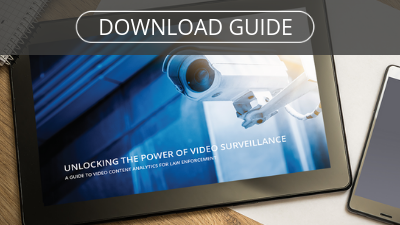Investigate with Artificial Intelligence and Digital Data to Solve Crimes Faster

The face of law enforcement is changing. With the introduction of artificial intelligence and data-driven technologies, governments, municipalities and police forces can streamline and accelerate investigations, uncovering evidence by leveraging new solutions. It’s estimated that 85% of all criminal cases are now solved using some sort of digital evidence. Whether it is utilized to confirm or support discovered physical evidence or to reveal additional information for accelerating suspect identification, this powerful set of data helps law enforcement enhance public safety and solve crimes.
Here is a look at the digital data modern police forces are leveraging to drive faster and more productive investigations:
Pinpointing Suspects with Face Recognition
Video evidence has always been an effective tool in law enforcement investigations, but the integration of more sophisticated high-resolution and connected cameras has made it possible to more effectively and efficiently pinpoint suspects and persons of interest. In part, this is because of video surveillance-based face recognition, which enables law enforcement to track suspects across video surveillance feeds and recordings. By creating suspect watchlists and configuring face recognition rules, police can receive real-time alerts when persons of interest are detected on camera. It can also be used post-event to search video for appearances of specific suspicious persons, helping police find evidence they need faster.
Extracting Intelligence from Video Surveillance
In an investigation, law enforcement can’t always point to specific suspects and track them with face recognition. However, video surveillance infrastructure can also be utilized for artificial intelligence and machine learning-driven video content analytics – a comprehensive solution for accelerating investigations: Video analytics detect and extract objects that appear in video, identify and classify them and then index the metadata so that the video can be searched and filtered based on known criteria; configured to trigger alerts when specific behaviors and conditions are met; and aggregated over time to uncover actionable intelligence about surveilled trends and patterns.
Combing Social Media for Evidence
According to data from Statista, 77% of Americans have a social media account of some sort, whether Twitter, Facebook, Instagram, Snapchat or something else. When it comes to investigating, social media can be a powerful tool for law enforcement’s analysis. Police can monitor a suspect’s profile or social media history to help piece together event timelines, draw connections between suspects and other persons of interest who appear in posted photos, and more. They can even subpoena accounts to access private messages that may not be publicly viewable. By law, law enforcement is permitted to create “undercover” accounts to connect with suspects or their family and friends. When these individuals accept undercover police accounts as connections, police are granted access to private areas of the account, which can provide key details for advancing an investigation.
Pursuing Clues in E-Mail Correspondence
Google reportedly receives tens of thousands of requests from law enforcement each year for access to data pertaining to users of its Gmail e-mail platform. E-mail correspondence is another way investigators can piece together event timelines, draw connections between incidents and individuals, and identify or rule out suspects. As a policy, e-mail messages more than 180 days old can be accessed by the authorities as long as there’s a subpoena and the account holder is notified beforehand. For accessing e-mails less than 180 days old, however, police must obtain a warrant.
Unlocking Evidence from Cell Phone Usage
From call logs to Internet browsing history and geolocation points, one’s smartphone stores a potential treasure trove of evidence. Police can leverage smartphone data, such as text messages, voicemails, photos and videos, as evidence for solving investigations. It’s worth noting, however, that cell phone analysis is usually only possible once suspects have been arrested. Otherwise, investigators likely will either need a warrant for a possession search or the suspect’s consent. For this reason, cell phone data is usually best served in furthering an investigation rather than as a starting point for a case.
Advancing Investigations in the Cloud
Resources like Dropbox, One Drive and Google Drive, among others, make it easy for individuals to store data in the cloud as opposed to filling up space on local devices and hard drives. In the event of an investigation, law enforcement can obtain a court order or a subpoena to access this data to further an active investigation.
Fingerprints, eye witness testimony, bodily fluids and firearms are all great examples of physical evidence traditionally leveraged to advance investigations and charge suspects. Complementing these sources of evidence, digital data extracted using machine learning and artificial intelligence capabilities, drives investigation efficiency and accuracy, helping law enforcement solve cases faster with more compelling evidence, while minimizing the dedicated time and manpower.
Signup to receive a monthly blog digest.
